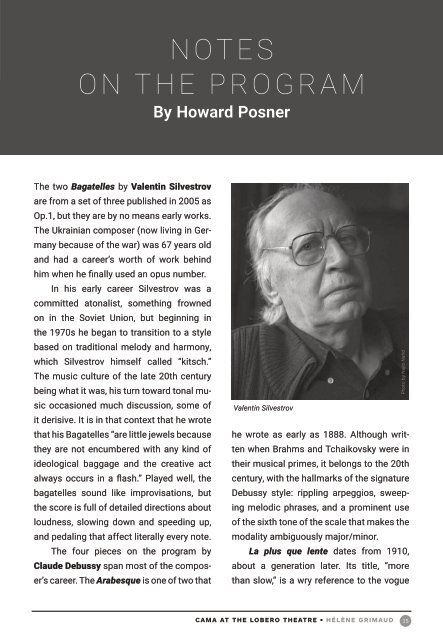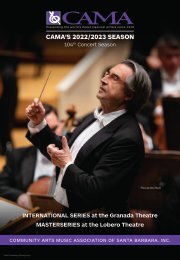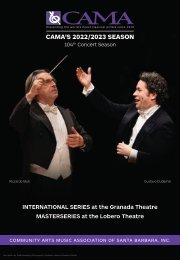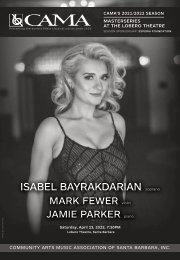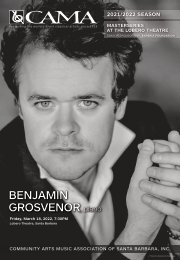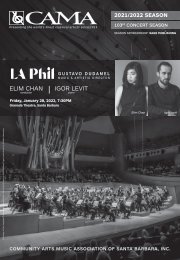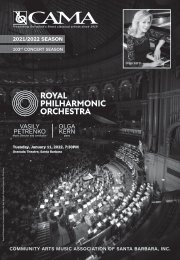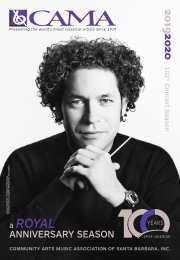Program Book | December 7, 2022 | CAMA presents Hélène Grimaud, piano | Masterseries at the Lobero Theatre, Santa Barbara
WEDNESDAY, DECEMBER 7, 2022, 7:30PM HÉLÈNE GRIMAUD, piano Direct from Carnegie Hall! French pianist Hélène Grimaud is a deeply passionate and committed musical artist with an original and probing mind who takes no note for granted. Her poetic expression and peerless technical control have drawn comparisons to Martha Argerich and Jorge Bolet. Her contribution to and impact on the world of classical music were recognized by the French government with admission to the Ordre National de la Légion d’Honneur (France’s highest decoration) at the rank of Chevalier (Knight). In her role as a passionate wildlife conservationist, Grimaud established the Wolf Conservation Center in upper New York State, which offers education about wolves, their relationship to the environment, and the human role in protecting their future. PROGRAM: VALENTIN SILVESTROV: Bagatelle I CLAUDE DEBUSSY: Arabesque No.1 VALENTIN SILVESTROV: Bagatelle II ERIK SATIE: Gnossienne No.4 FRÉDÉRIC CHOPIN: Nocturne No.19 in E Minor. Op.72, No.1 ERIK SATIE: Gnossienne No.1 ERIK SATIE: Six pièces froides IV—“Danses de travers No.1: En y regardant à deux fois” CLAUDE DEBUSSY: La plus que lente FRÉDÉRIC CHOPIN: Mazurka in A Minor, Op.17, No.4 FRÉDÉRIC CHOPIN: Waltz No.3 in A Minor, Op.34, No.2 CLAUDE DEBUSSY: “Clair de lune” from Suite bergamasque CLAUDE DEBUSSY: Rêverie ERIK SATIE: Six pièces froides V—“Danses de travers No.2: Passer” ROBERT SCHUMANN: Kreisleriana, Op.16 •
WEDNESDAY, DECEMBER 7, 2022, 7:30PM
HÉLÈNE GRIMAUD, piano
Direct from Carnegie Hall!
French pianist Hélène Grimaud is a deeply passionate and committed musical artist with an original and probing mind who takes no note for granted. Her poetic expression and peerless technical control have drawn comparisons to Martha Argerich and Jorge Bolet. Her contribution to and impact on the world of classical music were recognized by the French government with admission to the Ordre National de la Légion d’Honneur (France’s highest decoration) at the rank of Chevalier (Knight). In her role as a passionate wildlife conservationist, Grimaud established the Wolf Conservation Center in upper New York State, which offers education about wolves, their relationship to the environment, and the human role in protecting their future.
PROGRAM:
VALENTIN SILVESTROV: Bagatelle I
CLAUDE DEBUSSY: Arabesque No.1
VALENTIN SILVESTROV: Bagatelle II
ERIK SATIE: Gnossienne No.4
FRÉDÉRIC CHOPIN: Nocturne No.19 in E Minor. Op.72, No.1
ERIK SATIE: Gnossienne No.1
ERIK SATIE: Six pièces froides IV—“Danses de travers No.1: En y regardant à deux fois”
CLAUDE DEBUSSY: La plus que lente
FRÉDÉRIC CHOPIN: Mazurka in A Minor, Op.17, No.4
FRÉDÉRIC CHOPIN: Waltz No.3 in A Minor, Op.34, No.2
CLAUDE DEBUSSY: “Clair de lune” from Suite bergamasque
CLAUDE DEBUSSY: Rêverie
ERIK SATIE: Six pièces froides V—“Danses de travers No.2: Passer”
ROBERT SCHUMANN: Kreisleriana, Op.16
•
Create successful ePaper yourself
Turn your PDF publications into a flip-book with our unique Google optimized e-Paper software.
NOTES<br />
ON THE PROGRAM<br />
By Howard Posner<br />
The two Bag<strong>at</strong>elles by Valentin Silvestrov<br />
are from a set of three published in 2005 as<br />
Op.1, but <strong>the</strong>y are by no means early works.<br />
The Ukrainian composer (now living in Germany<br />
because of <strong>the</strong> war) was 67 years old<br />
and had a career’s worth of work behind<br />
him when he finally used an opus number.<br />
In his early career Silvestrov was a<br />
committed <strong>at</strong>onalist, something frowned<br />
on in <strong>the</strong> Soviet Union, but beginning in<br />
<strong>the</strong> 1970s he began to transition to a style<br />
based on traditional melody and harmony,<br />
which Silvestrov himself called “kitsch.”<br />
The music culture of <strong>the</strong> l<strong>at</strong>e 20th century<br />
being wh<strong>at</strong> it was, his turn toward tonal music<br />
occasioned much discussion, some of<br />
it derisive. It is in th<strong>at</strong> context th<strong>at</strong> he wrote<br />
th<strong>at</strong> his Bag<strong>at</strong>elles “are little jewels because<br />
<strong>the</strong>y are not encumbered with any kind of<br />
ideological baggage and <strong>the</strong> cre<strong>at</strong>ive act<br />
always occurs in a flash.” Played well, <strong>the</strong><br />
bag<strong>at</strong>elles sound like improvis<strong>at</strong>ions, but<br />
<strong>the</strong> score is full of detailed directions about<br />
loudness, slowing down and speeding up,<br />
and pedaling th<strong>at</strong> affect literally every note.<br />
The four pieces on <strong>the</strong> program by<br />
Claude Debussy span most of <strong>the</strong> composer’s<br />
career. The Arabesque is one of two th<strong>at</strong><br />
Valentin Silvestrov<br />
he wrote as early as 1888. Although written<br />
when Brahms and Tchaikovsky were in<br />
<strong>the</strong>ir musical primes, it belongs to <strong>the</strong> 20th<br />
century, with <strong>the</strong> hallmarks of <strong>the</strong> sign<strong>at</strong>ure<br />
Debussy style: rippling arpeggios, sweeping<br />
melodic phrases, and a prominent use<br />
of <strong>the</strong> sixth tone of <strong>the</strong> scale th<strong>at</strong> makes <strong>the</strong><br />
modality ambiguously major/minor.<br />
La plus que lente d<strong>at</strong>es from 1910,<br />
about a gener<strong>at</strong>ion l<strong>at</strong>er. Its title, “more<br />
than slow,” is a wry reference to <strong>the</strong> vogue<br />
Photo by Najib Nafid<br />
<strong>CAMA</strong> AT THE LOBERO THEATRE • HÉLÈNE GRIMAUD<br />
15


